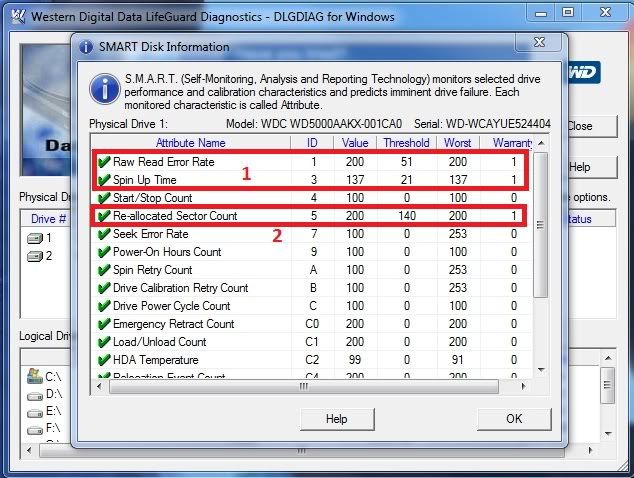[SOLVED] New drives: 200 bad sectors; normal?
Hi all,
I have got the weirdest problem ever.
I bought myself 2 500Gb Western Digital SATAII drives. Upon installment I could already RMA one because it was ticking and vibrating.
The second seemed ok, but is now (after two weeks) also showing problems. A few days ago I got a blue screen (Windows 7) with a HDD error and had to restore my backup to get my system working again.
What happens is this:
BoD
Computer reboots
chkdsk (or similar) runs and finds tons (really over one thousand) damaged files.
At times it manages to make the system startable, but at times it doesn't.
To check the SMART status of the disk I downloaded CrystalDiskInfo and ran that.
To my own surprise I noticed that both drives, which run as seperate ones (so not in a RAID config) have the exact same number of bad sectors: 200.
The tool however reports both disks as 'healthy'. Now I definitely am not a specialist on harddrives, but this seems really weird to me. How on earth can a disk come from the factory with already 200 bad sectors on it?
So my question is twofold:
1) Are these bad sectors the norm for disks nowadays?
2) Am I right in thinking that one of my drives might be faulty, even though SMART says it's healthy?
Which in reality leads automatically to the next question:
Should I consider getting a different set of HDDs? I'm getting the impression that these drives are just really crappy quality.
Thanks for any help in advance. Believe me, I need it. After spending almost £600 on a new system, I am really aggravated for already having to trouble shoot it.
Hi all,
I have got the weirdest problem ever.
I bought myself 2 500Gb Western Digital SATAII drives. Upon installment I could already RMA one because it was ticking and vibrating.
The second seemed ok, but is now (after two weeks) also showing problems. A few days ago I got a blue screen (Windows 7) with a HDD error and had to restore my backup to get my system working again.
What happens is this:
BoD
Computer reboots
chkdsk (or similar) runs and finds tons (really over one thousand) damaged files.
At times it manages to make the system startable, but at times it doesn't.
To check the SMART status of the disk I downloaded CrystalDiskInfo and ran that.
To my own surprise I noticed that both drives, which run as seperate ones (so not in a RAID config) have the exact same number of bad sectors: 200.
The tool however reports both disks as 'healthy'. Now I definitely am not a specialist on harddrives, but this seems really weird to me. How on earth can a disk come from the factory with already 200 bad sectors on it?
So my question is twofold:
1) Are these bad sectors the norm for disks nowadays?
2) Am I right in thinking that one of my drives might be faulty, even though SMART says it's healthy?
Which in reality leads automatically to the next question:
Should I consider getting a different set of HDDs? I'm getting the impression that these drives are just really crappy quality.
Thanks for any help in advance. Believe me, I need it. After spending almost £600 on a new system, I am really aggravated for already having to trouble shoot it.
Last edited:








